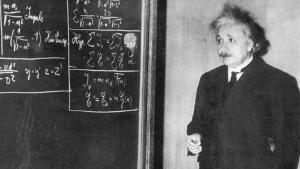Blog
Have You Heard
the One About…
3 July 2014
 Jacob Rader Marcus Center of the American Jewish Archives
Jacob Rader Marcus Center of the American Jewish ArchivesThis week I’ve gotten a number of questions about various proposed models in astrophysics, such as the one about how anti-gravity could explain dark matter and dark energy.1 Or the one where dark matter is a result of quantum interference on a cosmic scale.2 Or the one where the cosmic microwave background is actually due to thermal turbulence rather than the big bang.3 There are lots of ideas that show up in the literature and in the press, so how do you judge the quality of a particular idea?
When I look at a paper, I usually start with broad claims and narrow down to the specific. Initially I look for any obvious red flags. For example, the claim that the cosmic background is thermal turbulence is a big flag. A central claim of the work is that the big bang and all the related physics (redshift, cosmic inflation, etc.) are all wrong. As I’ve written earlier, there is a great deal of observational support for the big bang. You don’t get to be a robust scientific theory without strong evidence, so a paper claiming a robust theory is fundamentally wrong better have some Nobel prize level evidence. In this case, the paper makes broad claims but only cites minor observations that the author feels agrees with their revolutionary model. So it is pretty clear the work is unsubstantiated.
The “broad claim” approach is often made by so-called “crank” science, where a revolutionary new approach is proposed that is obviously correct. Since extraordinary claims require extraordinary evidence, they are also the easiest to dismiss. The response is often to accuse “establishment” science as being closed minded, or not willing to learn their new and radical model. But as we’ve seen from the recent BICEP2 drama, even a skilled team of researchers studying well accepted models can overstate their results. Pointing out obvious flaws in a model isn’t being closed minded, it is actually treating the work scientifically.
The other two papers look at effects attributed to dark matter. They don’t make claims that sweep away established physics. So the next step is to see if they introduce any “new” physics. The anti-gravity paper does this by asserting that virtual particles in empty space could induce an anti-gravity effect. Like an earlier paper looking at a difference in the speed of light, this paper treats virtual particles as real ones, which is a contentious approach. In this paper they go further and claim that matter and antimatter gravitationally repel each other.
This is an idea that has been looked at before. There have even been recent experiments trying to determine if antimatter “falls up” as it were. So far the results are inconclusive, but it is generally thought that antimatter will fall just like matter. If it doesn’t, that would have dire consequences for established models such as general relativity. So this paper depends upon new physics for which there is no evidence, which puts it on weak ground. But the authors also propose an experimental test, which is a point in their favor. Specifically they note that if quantum antimatter is a cause of dark matter effects, it should affect the orbit of distant Kuiper belt objects such as (55637) 2002 UX25.
So radical new physics, but also a clear predictive test of the model. This puts the paper in the “fringe” category. That is, very speculative but making testable predictions. If experiments show that antimatter does indeed fall up, then it might be worth looking at Kuiper belt objects for antigravity effects. For now, though, it is just an idea.
The last paper takes a different approach to dark matter. In this case the paper doesn’t introduce new physics, but takes established physics and applies it in new ways. The paper looks to address a very specific weakness in the standard cold dark matter (CDM) model. Specifically the fact that dwarf galaxies don’t fit the model as well as we’d like. Combine this with the fact that we haven’t directly observed dark matter particles, and you have a perfect opening for new ideas. Here the paper proposes that dark matter is not only cold, but super-cold. So cold that it acts as a Bose-Einstein condensate. Put simply, this would mean that dark matter could act as a single quantum system. Computer simulations show that the model could address the difficulty with dwarf galaxies.
So this last paper makes a new approach to a clear difficulty in current models, and doesn’t invoke controversial new physics. It hasn’t made any clear predictions to distinguish it from other models, but it is the type of new idea that mainstream theorists propose to address observational difficulties. As the model is developed further, and we gather more observational evidence, we’ll be able to determine if the model is viable.
Astrophysics is a difficult field, and it is always good to look at new ideas. But as we can see, some ideas have more potential than others.
Gai, Mario, and Alberto Vecchiato. “Astrometric detection feasibility of gravitational effects of quantum vacuum.” arXiv preprint arXiv:1406.3611 (2014). ↩︎
Schive, Hsi-Yu, Tzihong Chiueh, and Tom Broadhurst. “Cosmic structure as the quantum interference of a coherent dark wave.” Nature Physics 10.7 (2014): 496-499. ↩︎
Fahr, Hans J. “The big bluff: Or is the ‘big bang cosmology’ going to collapse?.” ↩︎